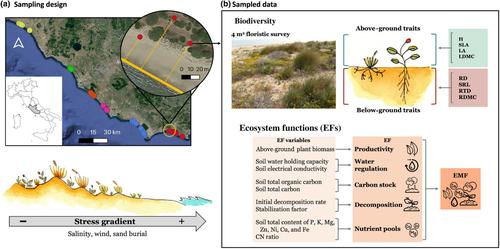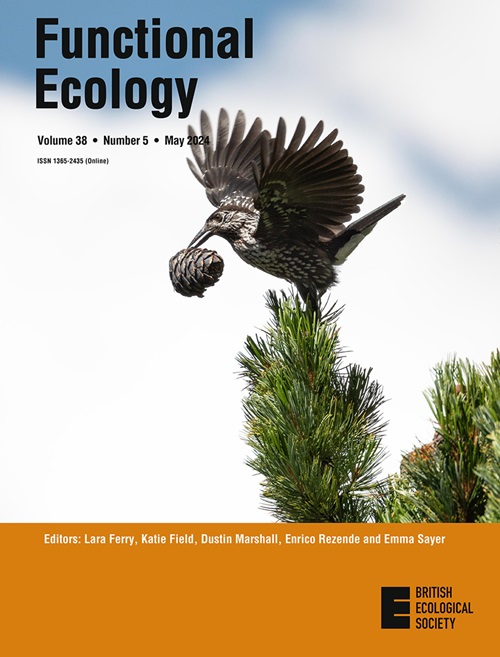Below-ground traits, rare species and environmental stress regulate the biodiversity–ecosystem function relationship
IF 4.6
1区 环境科学与生态学
Q1 ECOLOGY
引用次数: 0
Abstract
Read the free Plain Language Summary for this article on the Journal blog.


地下特征、稀有物种和环境压力调节着生物多样性与生态系统功能之间的关系
了解生物多样性与生态系统功能(BEF)之间的关系对于预测全球生物多样性不断丧失的后果至关重要。然而,人们对全球变化条件下自然生态系统中生物多样性与生态系统功能关系的驱动因素仍然知之甚少。为了填补这一知识空白,我们对沿自然环境压力梯度分布的沿海沙丘植物群落的数据采用了基于性状的方法。具体来说,我们比较了地下性状和地上性状在预测生产力、分解、水调节、碳储量和养分库方面的相对重要性,并测试了这些BEF关系如何受环境压力和通常被排除在实验系统之外的稀有物种的影响。在驱动生态系统功能方面,地下特征与地上特征同样重要。此外,尽管稀有物种的丰度较低,但它们对生态系统的多功能性(EMF)有积极影响。然而,随着环境压力的增加,大多数生物多样性的影响变得越来越弱。我们的研究表明,要了解生态系统功能的变异,我们必须像考虑地面特征一样考虑地下特征。此外,这项研究还强调了保护稀有物种对维持电磁场的重要性。不过,我们的研究结果也表明,全球的快速变化可能会削弱多样性对生态系统功能的积极影响。在期刊博客上免费阅读本文的通俗语言摘要。
本文章由计算机程序翻译,如有差异,请以英文原文为准。
求助全文
约1分钟内获得全文
求助全文
来源期刊

Functional Ecology
环境科学-生态学
CiteScore
9.00
自引率
1.90%
发文量
243
审稿时长
4 months
期刊介绍:
Functional Ecology publishes high-impact papers that enable a mechanistic understanding of ecological pattern and process from the organismic to the ecosystem scale. Because of the multifaceted nature of this challenge, papers can be based on a wide range of approaches. Thus, manuscripts may vary from physiological, genetics, life-history, and behavioural perspectives for organismal studies to community and biogeochemical studies when the goal is to understand ecosystem and larger scale ecological phenomena. We believe that the diverse nature of our journal is a strength, not a weakness, and we are open-minded about the variety of data, research approaches and types of studies that we publish. Certain key areas will continue to be emphasized: studies that integrate genomics with ecology, studies that examine how key aspects of physiology (e.g., stress) impact the ecology of animals and plants, or vice versa, and how evolution shapes interactions among function and ecological traits. Ecology has increasingly moved towards the realization that organismal traits and activities are vital for understanding community dynamics and ecosystem processes, particularly in response to the rapid global changes occurring in earth’s environment, and Functional Ecology aims to publish such integrative papers.
 求助内容:
求助内容: 应助结果提醒方式:
应助结果提醒方式:


